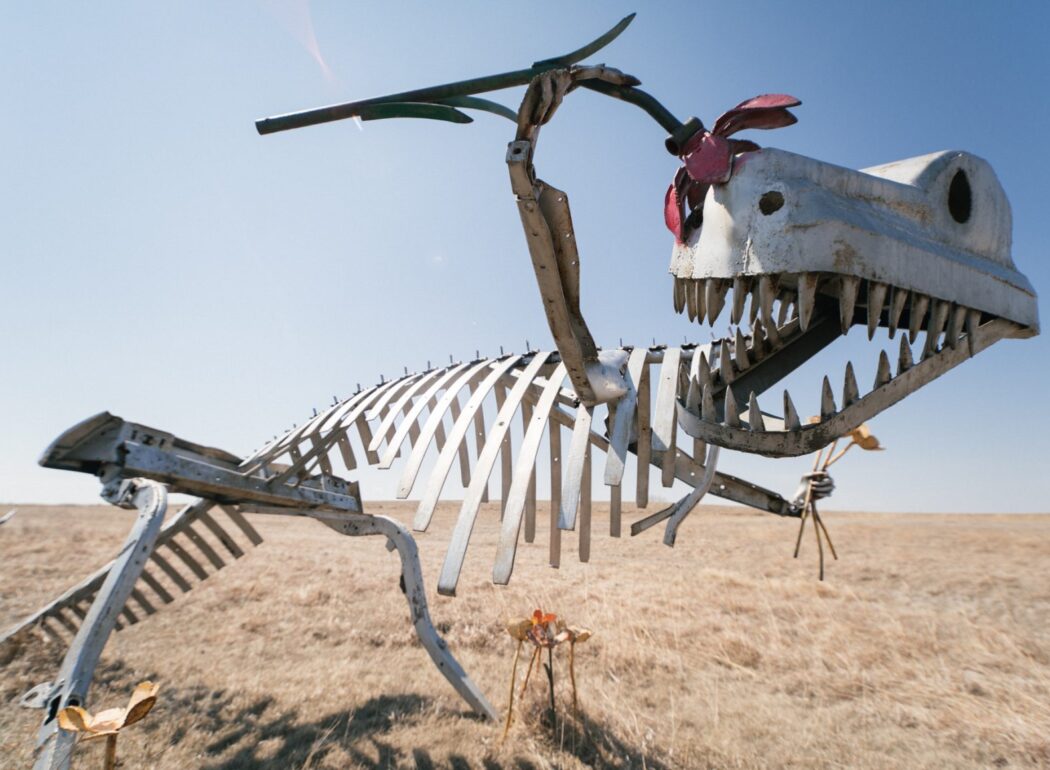 In Montrose, South Dakota lurks the Porter Sculpture Park, an outdoor collection of over 50 idiosyncratic pieces by artist Wayne Porter. His art is designed for interaction: those who visit the Park’s 18 acres are encouraged to touch and ride his sculptures. You can read about the Park and see some of Porter’s art by visiting the Park’s website and the entry on Porter’s Park on the Ghost of North America site, or simply by doing a Google image search of “Porter Sculpture Park.” And there’s a short, spooky, childlike video available on YouTube of the Park at dusk and nighttime.
In Montrose, South Dakota lurks the Porter Sculpture Park, an outdoor collection of over 50 idiosyncratic pieces by artist Wayne Porter. His art is designed for interaction: those who visit the Park’s 18 acres are encouraged to touch and ride his sculptures. You can read about the Park and see some of Porter’s art by visiting the Park’s website and the entry on Porter’s Park on the Ghost of North America site, or simply by doing a Google image search of “Porter Sculpture Park.” And there’s a short, spooky, childlike video available on YouTube of the Park at dusk and nighttime.
 For over two years, cartoonist George Gant has been posting his all-ages Beware of Toddler comic strips online. The strip chronicles the adventures of a stay-at-home dad raising both a pre-teen son and the star of the comic, a precocious two-year-old daughter. Drawn by Gant in a charming style, Beware of Toddler is available on Webtoons and at Gant’s Instagram account, alongside other comics and illustrations. Also visit Gant’s website for samples of his other strips, his illustration work, and art he’s done for fans.
For over two years, cartoonist George Gant has been posting his all-ages Beware of Toddler comic strips online. The strip chronicles the adventures of a stay-at-home dad raising both a pre-teen son and the star of the comic, a precocious two-year-old daughter. Drawn by Gant in a charming style, Beware of Toddler is available on Webtoons and at Gant’s Instagram account, alongside other comics and illustrations. Also visit Gant’s website for samples of his other strips, his illustration work, and art he’s done for fans.

Joye Evelyn Hummel was 97 years old when she passed away on April 5, 2021. Back in 1944, she was preparing to graduate from secretarial college when she was offered a job by her Psychology instructor, William Moulton Marston, the co-creator of Wonder Woman. Marston wanted Hummel to write stories for the Wonder Woman comic book (she would be the first woman to do so), but there was a catch. According to the Lambiek Comiclopedia: “The only condition was that [Hummel] would have to ghost-write them under [Marston’s] name. She accepted and their first stories appeared in Wonder Woman issue #12 (Spring 1945).” Hummel worked with Marston for three years, and was then forgotten until the early 1970s, when fan researchers unearthed Hummel’s scripts and interviewed her. In her 2014 book The Secret History of Wonder Woman, historian Jill Lepore discussed in depth Hummel’s contribution to the character. In 2018, Hummel traveled from Florida to San Diego to receive Comicon’s Bill Finger Award for Excellence in Comic Book Writing, and received a standing ovation from fans during a panel on her work. Obituaries and commentaries appeared after Hummel’s recent death: see here and here. Alex Jay, at the Tenth Letter of the Alphabet blog, dives into census records and high school yearbooks to trace Hummel’s life.
 CBS This Morning reporter Vladimir Duthiers filed a piece on “the history of female superheroes and how they’ve been represented over time.” Duthiers interviews artist and historian Trina Robbins, the first woman to draw a Wonder Woman comic book, and they discuss early strong-heroine characters like Sheena, Queen of the Jungle, even while lamenting that older superhero stories typically consigned women to a secondary “girlfriend” role. (Robbins mentions Nell Brinkley, a fantastic newspaper comics artist and one of the subjects of a recent Robbins book.) Also interviewed is Ariell Johnson, owner of Philadelphia’ Amalgam Comics, who talks about how Storm, the weather-controlling member of the X-Men (pictured above), inspired her to become a comics fan and retailer.
CBS This Morning reporter Vladimir Duthiers filed a piece on “the history of female superheroes and how they’ve been represented over time.” Duthiers interviews artist and historian Trina Robbins, the first woman to draw a Wonder Woman comic book, and they discuss early strong-heroine characters like Sheena, Queen of the Jungle, even while lamenting that older superhero stories typically consigned women to a secondary “girlfriend” role. (Robbins mentions Nell Brinkley, a fantastic newspaper comics artist and one of the subjects of a recent Robbins book.) Also interviewed is Ariell Johnson, owner of Philadelphia’ Amalgam Comics, who talks about how Storm, the weather-controlling member of the X-Men (pictured above), inspired her to become a comics fan and retailer.


From My Modern Met: A celebration of the centuries-old technique of silk screen printing, where an artist pushes different colors of paint through multiple stenciled screens to create a layered, vibrant image on paper or fabric. Writer Emma Taggert zeroes in on several key screen artists (Andy Warhol, Roy Lichtenstein, Clare Halifax, Alice Pattullo, Jermaine Rogers, more) and provides generous samples of each’s work and videos of their processes. (The portrait above is by Chuck Sperry, who is inspired by “the spirit of the modern rock poster, graffiti, and the utopian ethos of 1960s psychedelia.”) But you don’t need to look far to find talented silk screeners: Durham, NC’s Chris Williams—once a student of mine, now an accomplished cartoonist and artist—has been screening gig posters and tongue-in-cheek superhero images since 2003. Browse Chris’ collection here, and drink in his Ben Day dot / Lichtenstein / Jack Kirby mash-up below.

This weekly blog post is written and compiled by Craig Fischer. To send along recommendations, ideas, and comments, contact Craig at [email protected] [.]


